Characteristics of fuels and fire risk among the main forest types in Hoang Lien National Park
Hoang Lien National Park has 25,113.66 ha of forest under its management, including the main forest types as natural broadleaf evergreen forest (poor; average and rehabilitation forests), bamboo, bamboo and mixed forests, and plantation forest. There are small areas of natural rich forest left, mainly located in strictly protected zone, and 2,143.75 ha of uncovered land or area of regenerating woody plants. There are clear differences in terms of fuels among forest types that were clarified by using indicators as trunk height, height and cover of understory vegetation, load and moisture of fuels. From the characteristics of fuels, the study divided fire risk for forests, shrublands and grasslands into 4 levels of danger. As a result, shrubs and grasses and bamboo forest are at highest fire risk (level IV); Plantation forest and evergreen poor forest are at high risk of fire (level III); Rehabilitation forests are at medium risk (level II); and evergreen average and rich forests are at low risk (level I). From the results above, this study also has created a map of fire risk division for forest types in Hoang Lien National Park
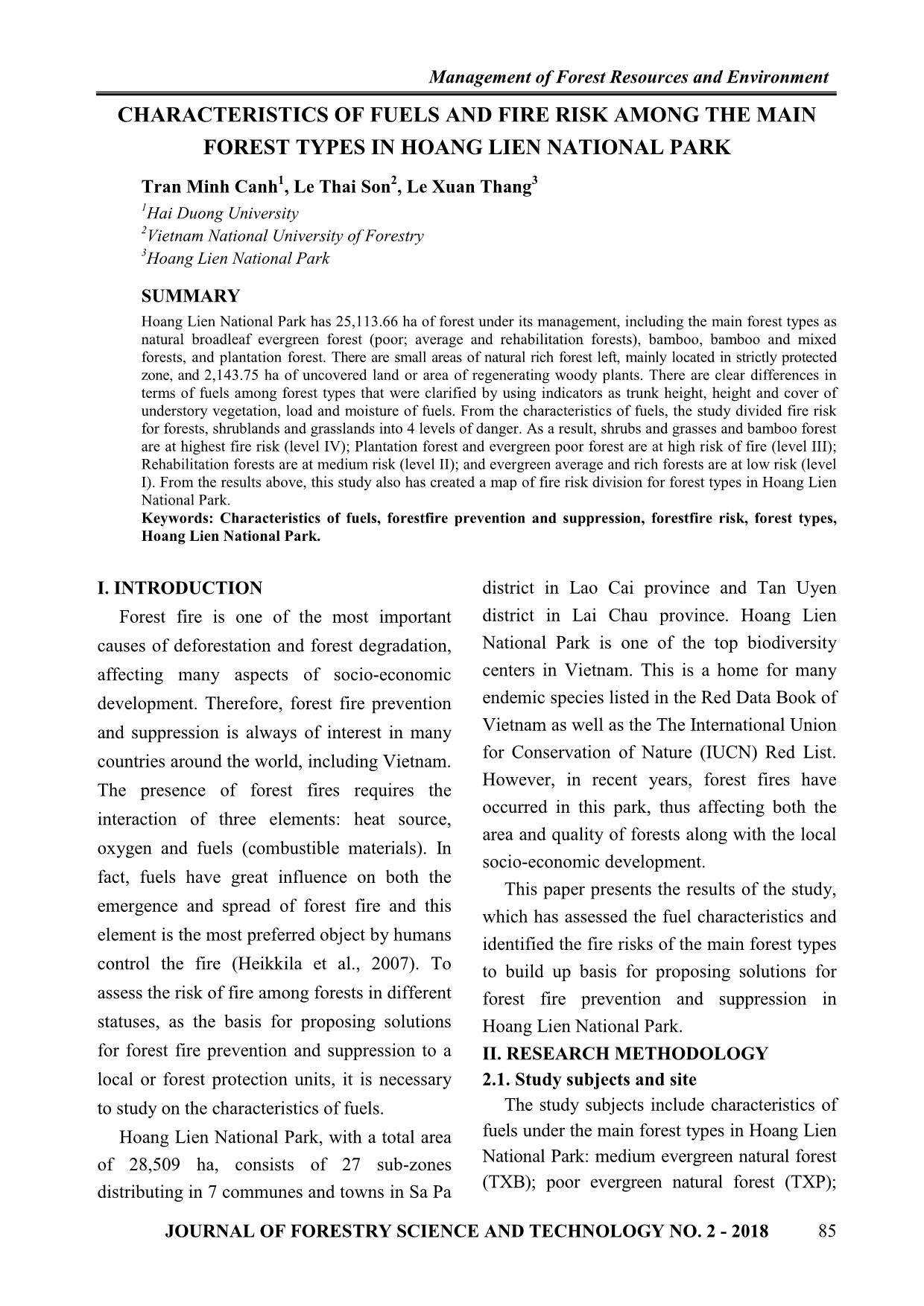
Trang 1
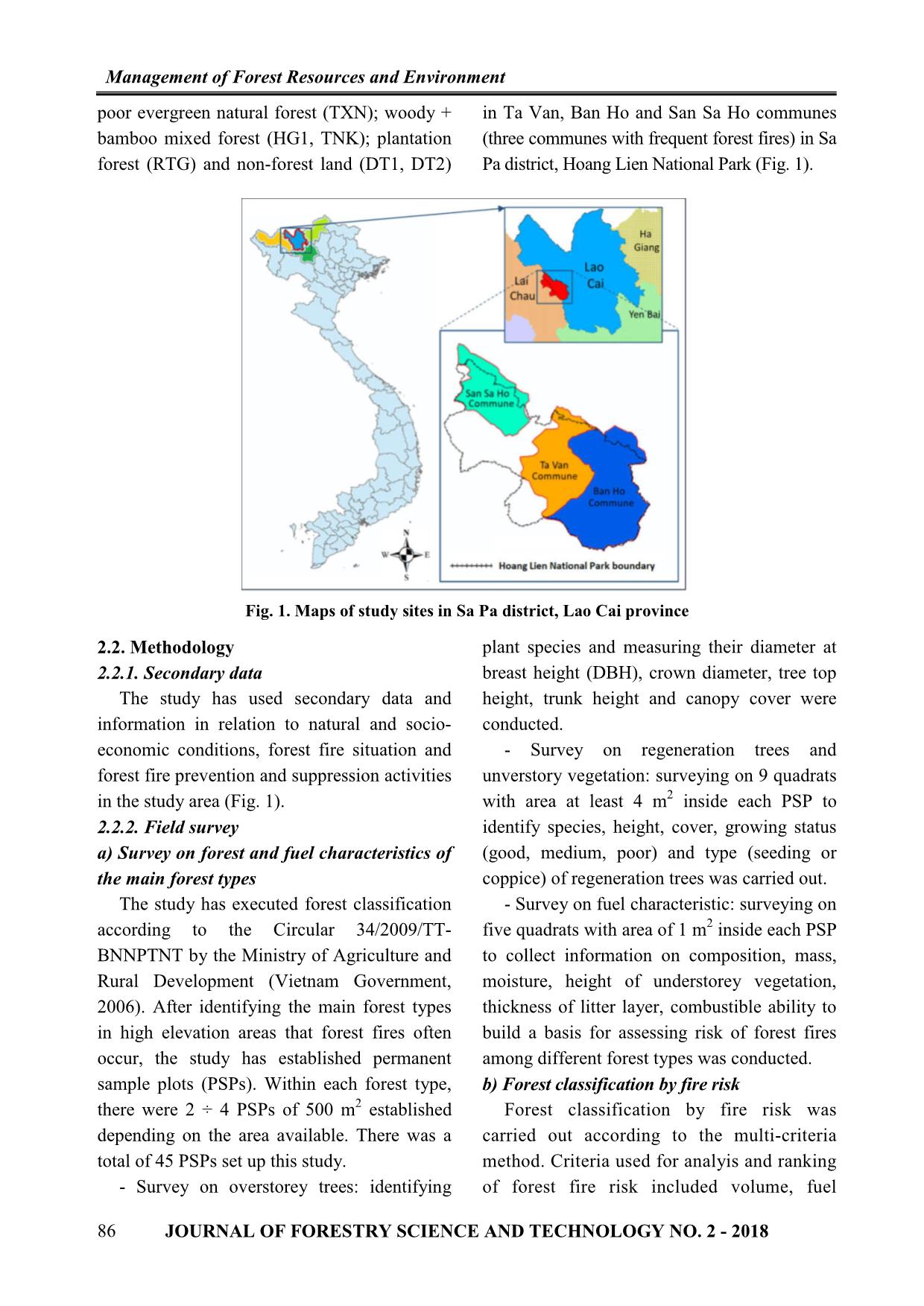
Trang 2
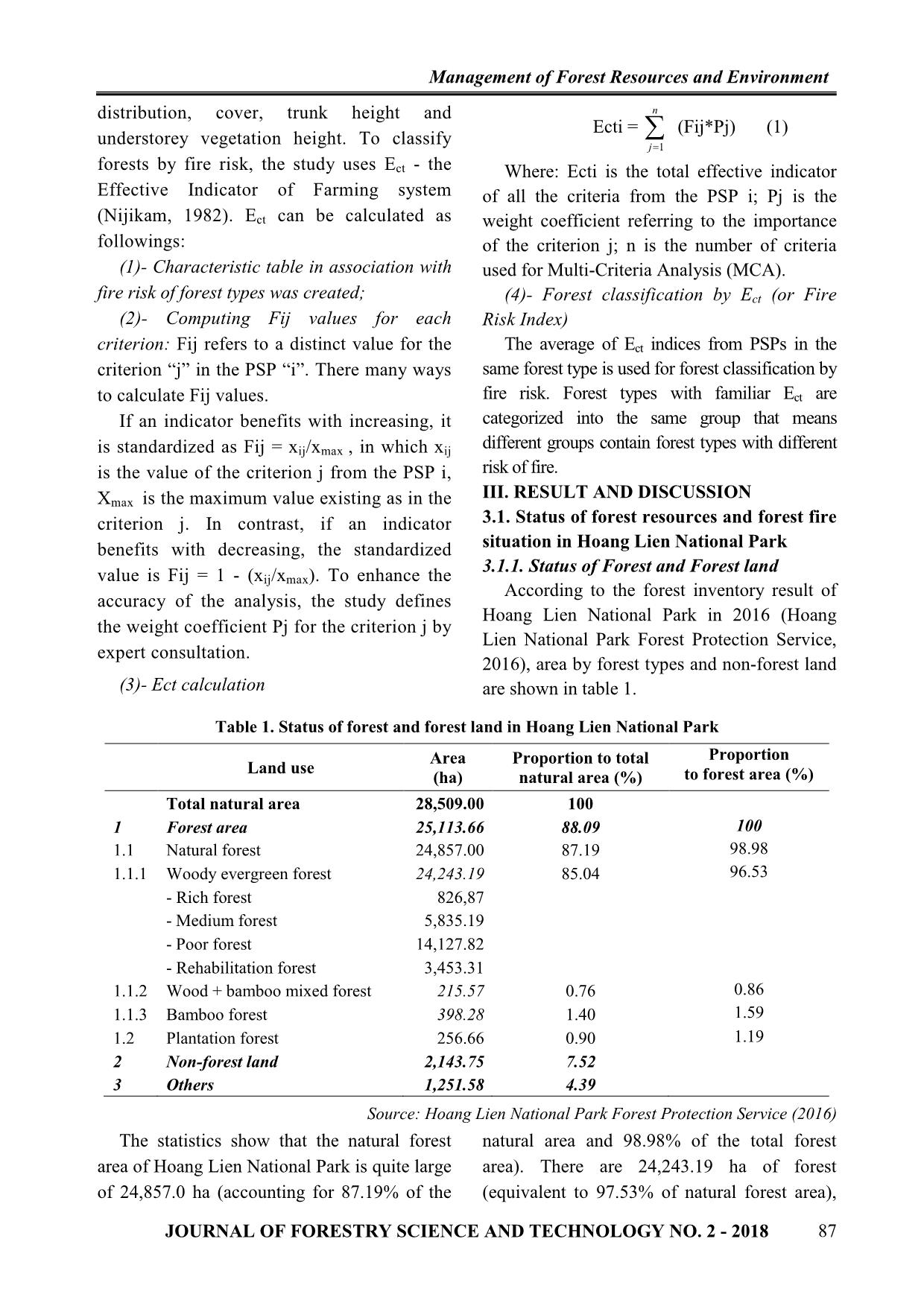
Trang 3
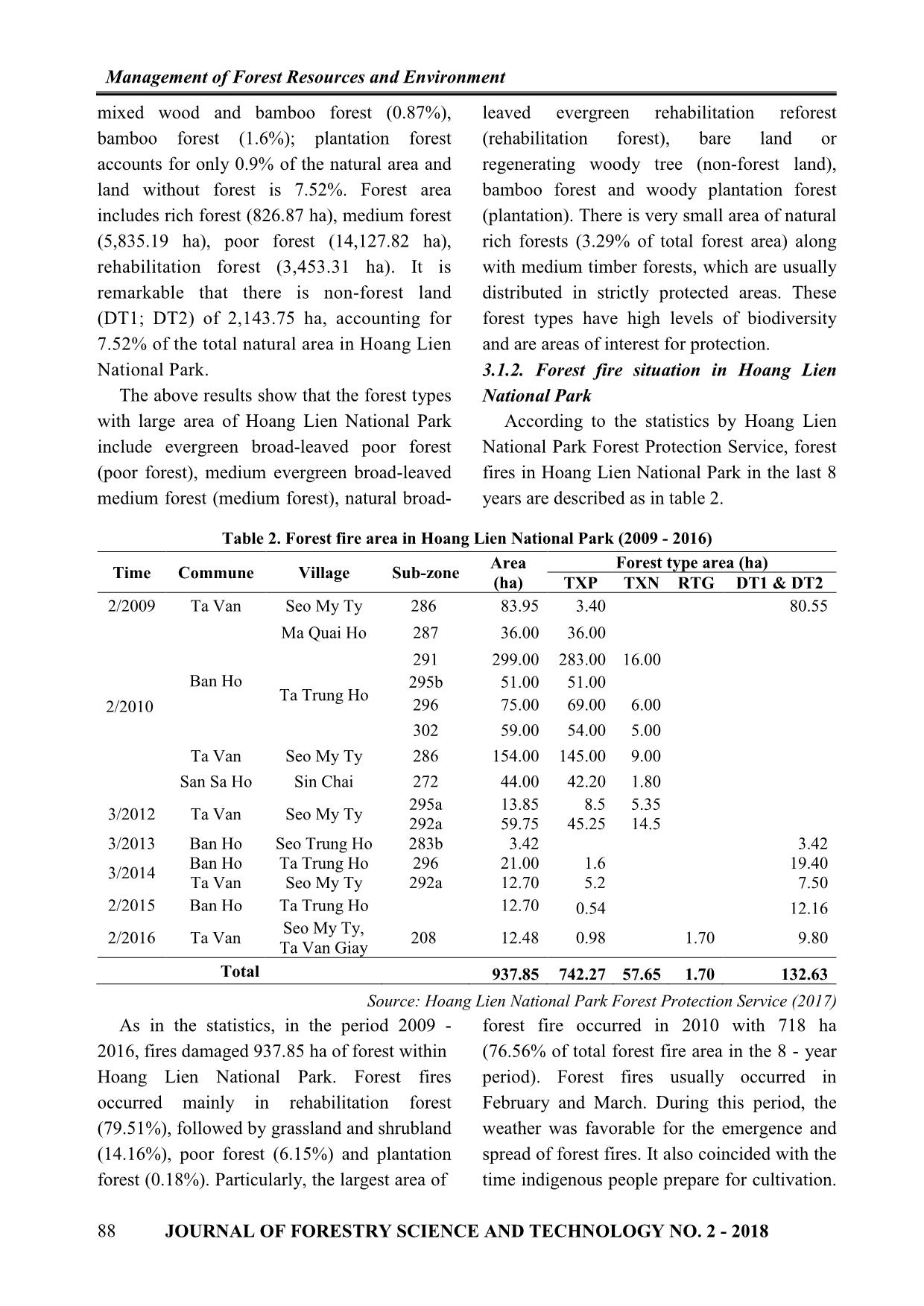
Trang 4
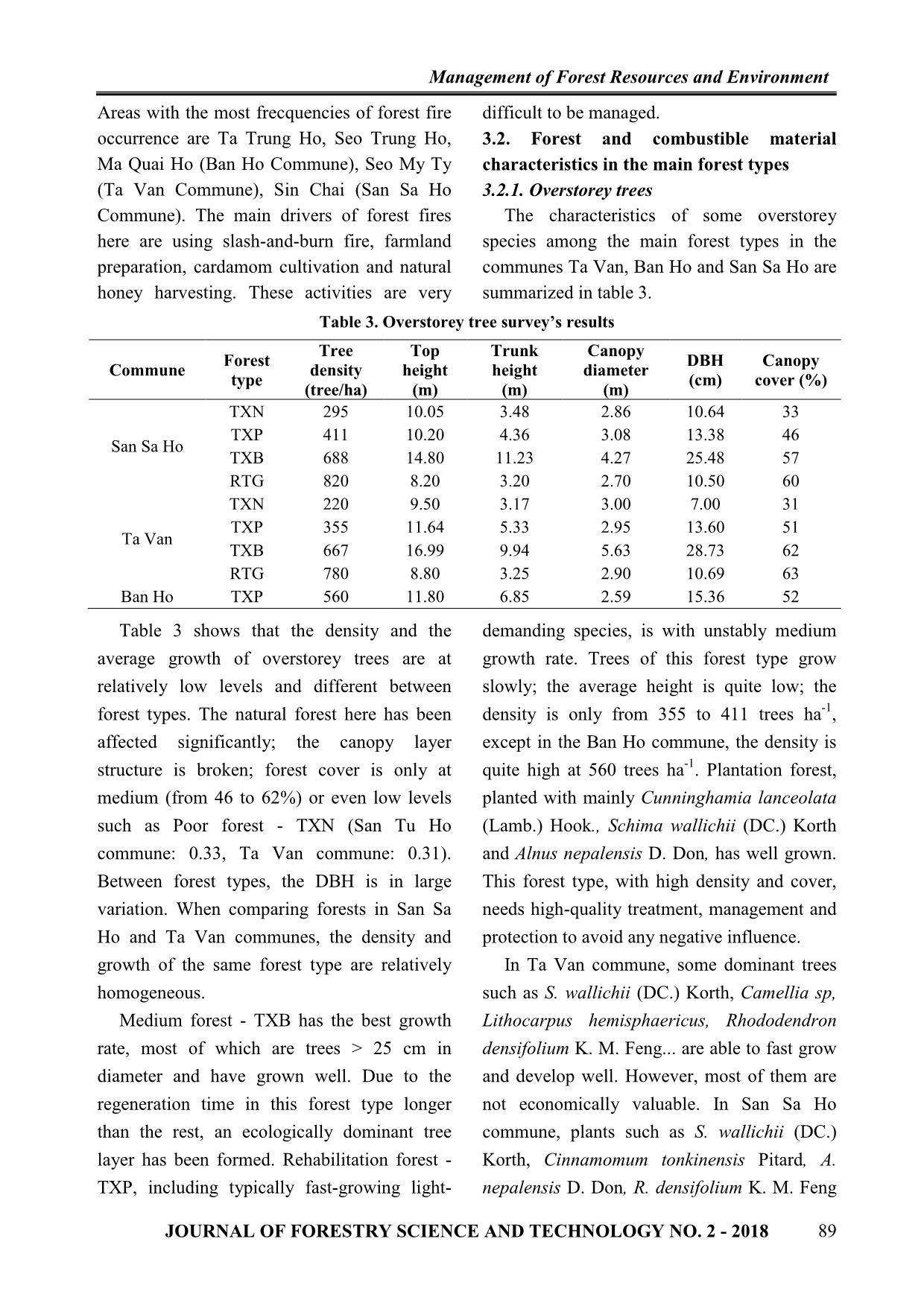
Trang 5
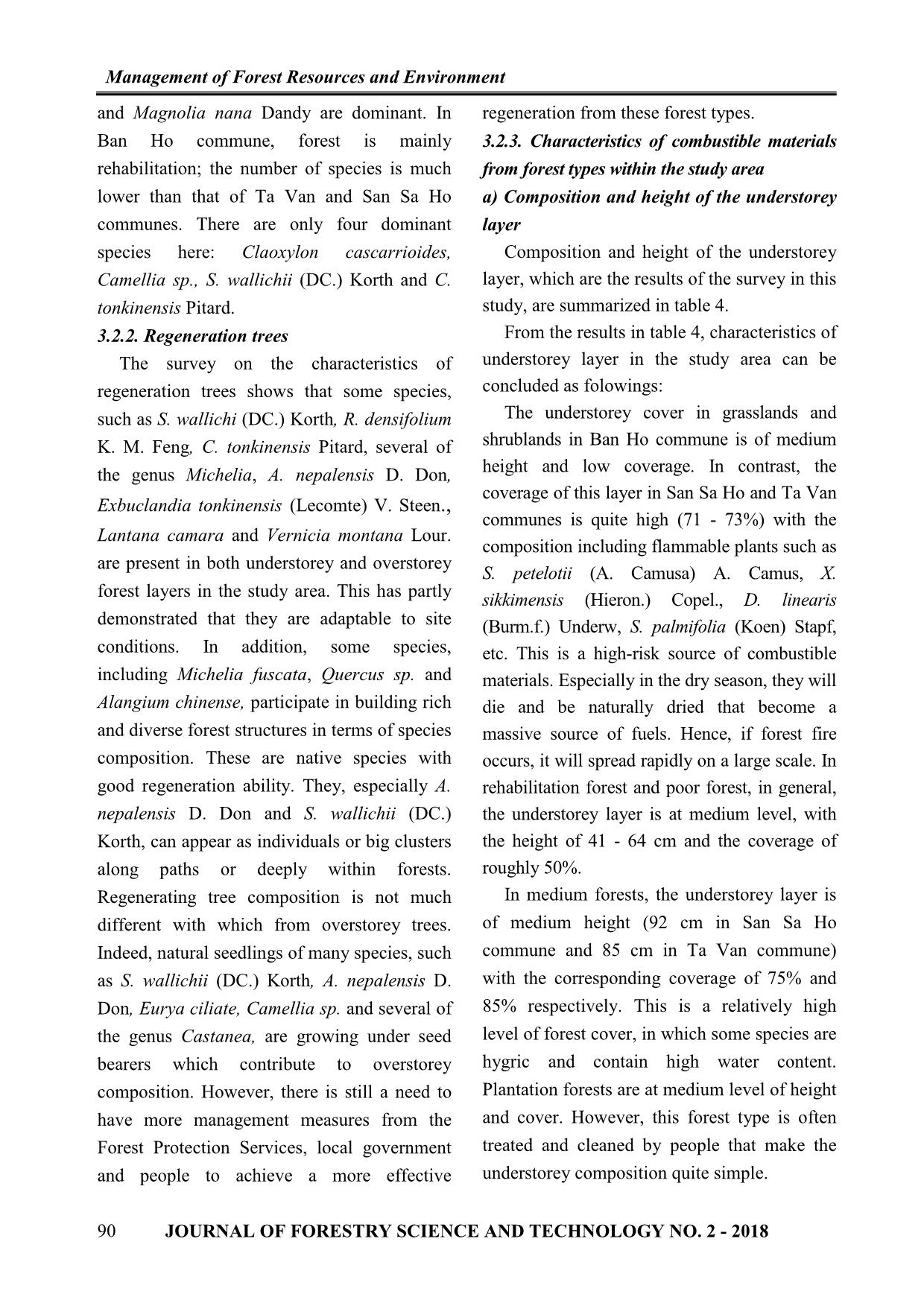
Trang 6
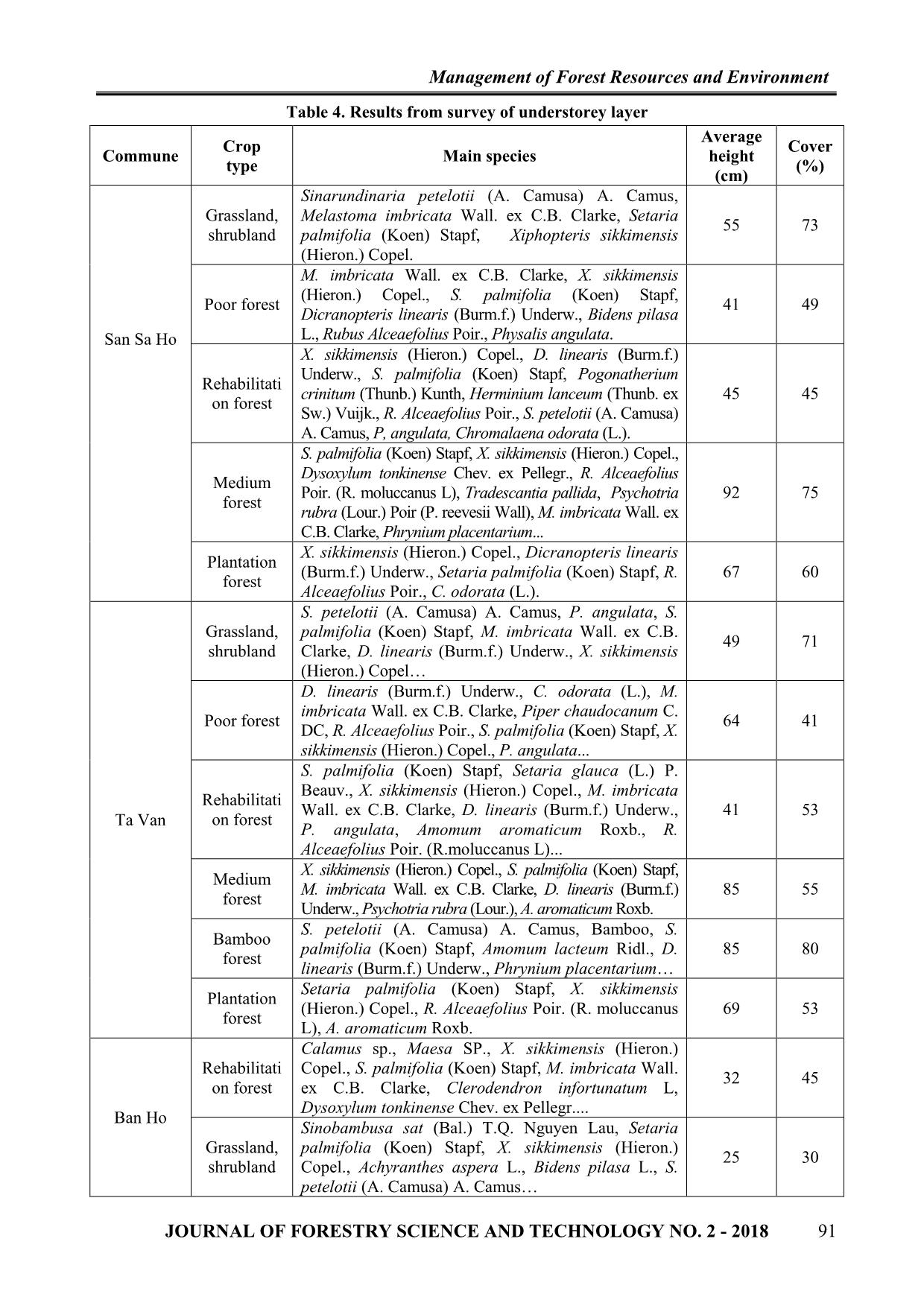
Trang 7
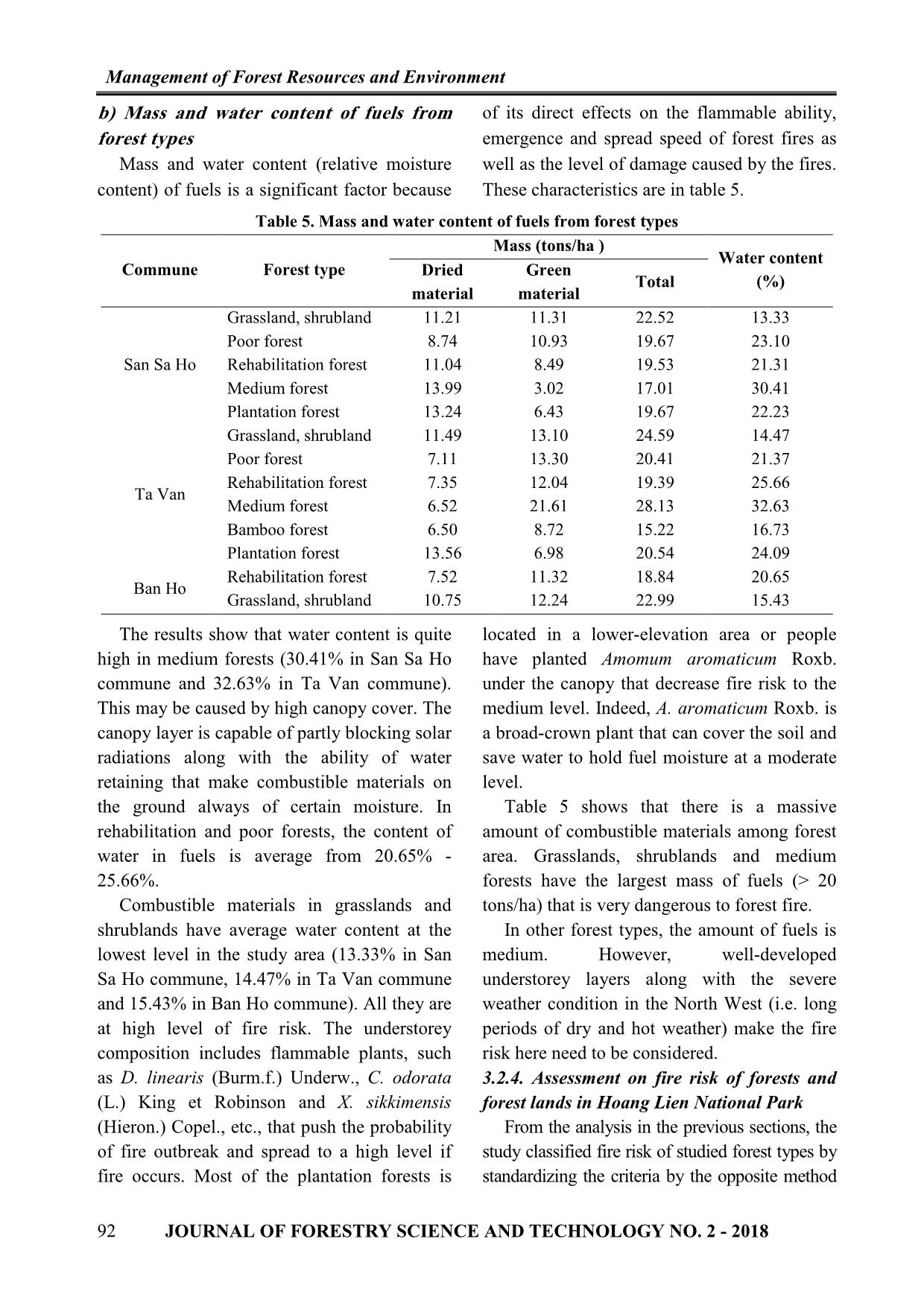
Trang 8
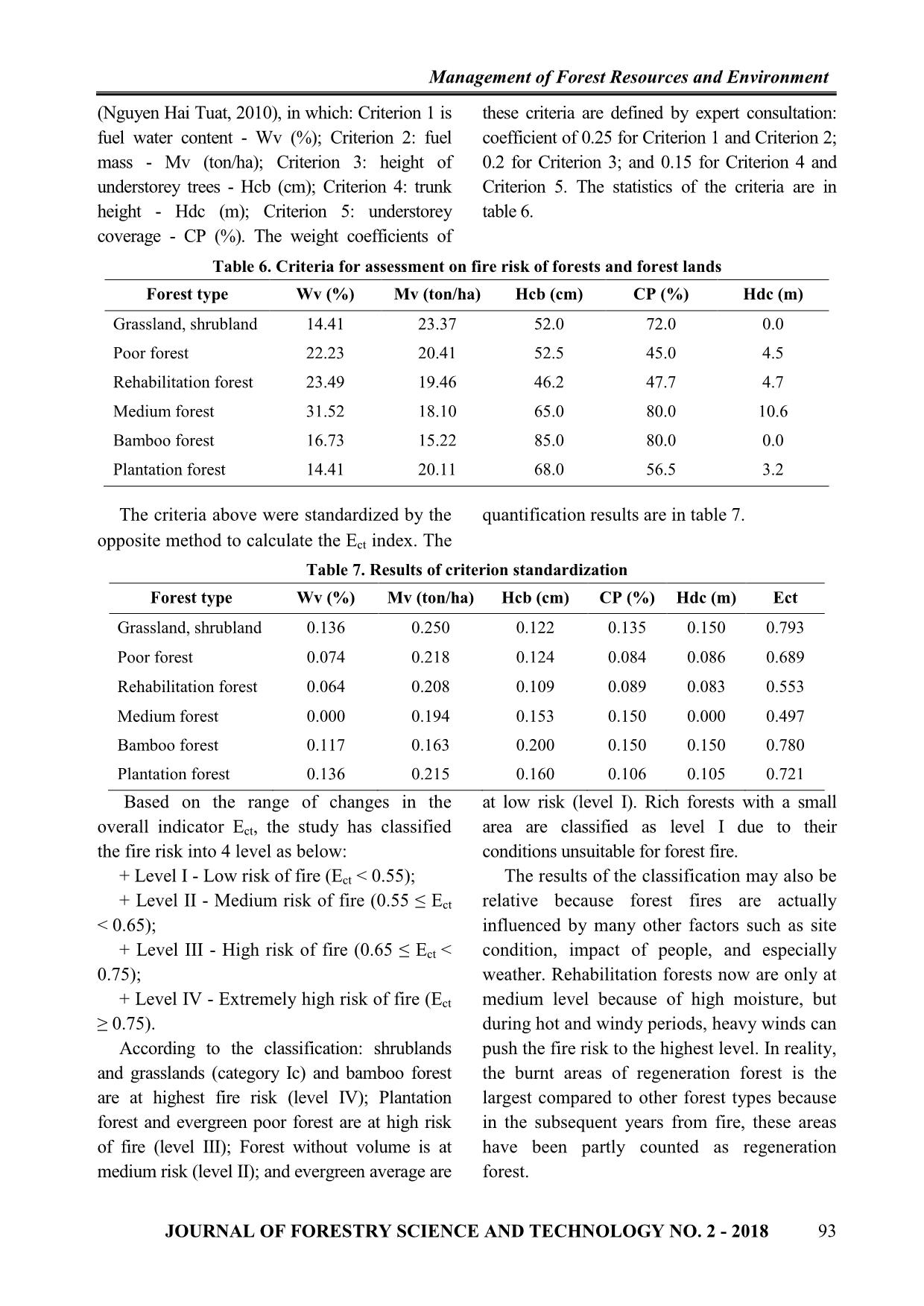
Trang 9
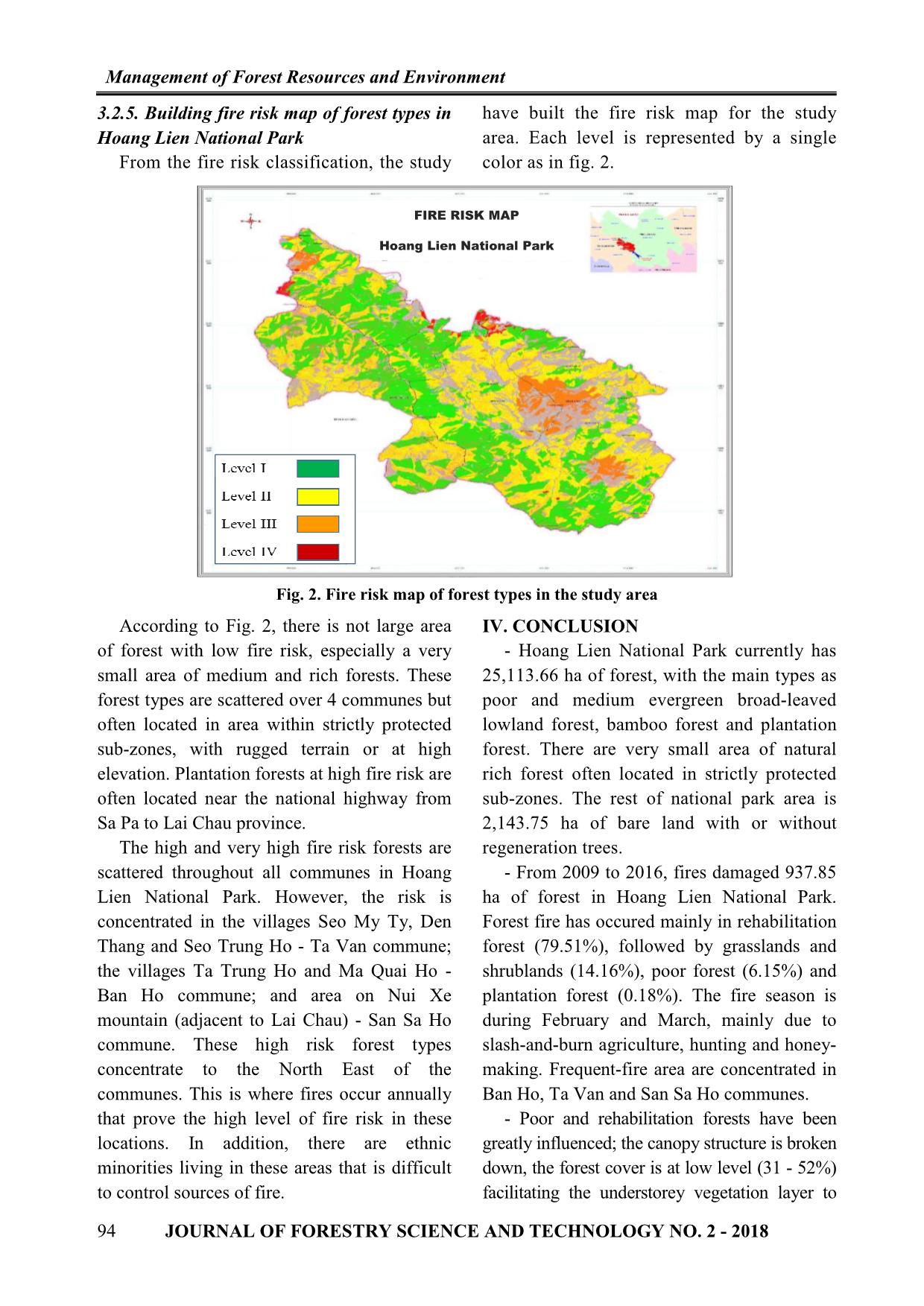
Trang 10
Tải về để xem bản đầy đủ
Tóm tắt nội dung tài liệu: Characteristics of fuels and fire risk among the main forest types in Hoang Lien National Park
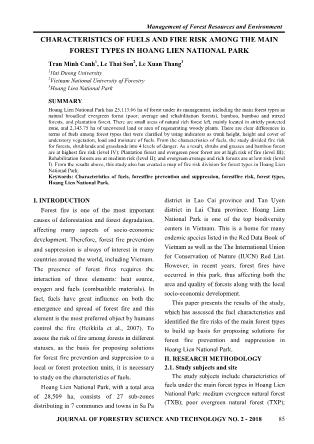
on.) Copel., S. palmifolia (Koen) Stapf, Poor forest 41 49 Dicranopteris linearis (Burm.f.) Underw., Bidens pilasa San Sa Ho L., Rubus Alceaefolius Poir., Physalis angulata. X. sikkimensis (Hieron.) Copel., D. linearis (Burm.f.) Underw., S. palmifolia (Koen) Stapf, Pogonatherium Rehabilitati crinitum (Thunb.) Kunth, Herminium lanceum (Thunb. ex 45 45 on forest Sw.) Vuijk., R. Alceaefolius Poir., S. petelotii (A. Camusa) A. Camus, P, angulata, Chromalaena odorata (L.). S. palmifolia (Koen) Stapf, X. sikkimensis (Hieron.) Copel., Dysoxylum tonkinense Chev. ex Pellegr., R. Alceaefolius Medium Poir. (R. moluccanus L), Tradescantia pallida, Psychotria 92 75 forest rubra (Lour.) Poir (P. reevesii Wall), M. imbricata Wall. ex C.B. Clarke, Phrynium placentarium... X. sikkimensis (Hieron.) Copel., Dicranopteris linearis Plantation (Burm.f.) Underw., Setaria palmifolia (Koen) Stapf, R. 67 60 forest Alceaefolius Poir., C. odorata (L.). S. petelotii (A. Camusa) A. Camus, P. angulata, S. Grassland, palmifolia (Koen) Stapf, M. imbricata Wall. ex C.B. 49 71 shrubland Clarke, D. linearis (Burm.f.) Underw., X. sikkimensis (Hieron.) Copel D. linearis (Burm.f.) Underw., C. odorata (L.), M. imbricata Wall. ex C.B. Clarke, Piper chaudocanum C. Poor forest 64 41 DC, R. Alceaefolius Poir., S. palmifolia (Koen) Stapf, X. sikkimensis (Hieron.) Copel., P. angulata... S. palmifolia (Koen) Stapf, Setaria glauca (L.) P. Beauv., X. sikkimensis (Hieron.) Copel., M. imbricata Rehabilitati Wall. ex C.B. Clarke, D. linearis (Burm.f.) Underw., 41 53 Ta Van on forest P. angulata, Amomum aromaticum Roxb., R. Alceaefolius Poir. (R.moluccanus L)... X. sikkimensis (Hieron.) Copel., S. palmifolia (Koen) Stapf, Medium M. imbricata Wall. ex C.B. Clarke, D. linearis (Burm.f.) 85 55 forest Underw., Psychotria rubra (Lour.), A. aromaticum Roxb. S. petelotii (A. Camusa) A. Camus, Bamboo, S. Bamboo palmifolia (Koen) Stapf, Amomum lacteum Ridl., D. 85 80 forest linearis (Burm.f.) Underw., Phrynium placentarium Setaria palmifolia (Koen) Stapf, X. sikkimensis Plantation (Hieron.) Copel., R. Alceaefolius Poir. (R. moluccanus 69 53 forest L), A. aromaticum Roxb. Calamus sp., Maesa SP., X. sikkimensis (Hieron.) Rehabilitati Copel., S. palmifolia (Koen) Stapf, M. imbricata Wall. 32 45 on forest ex C.B. Clarke, Clerodendron infortunatum L, Dysoxylum tonkinense Chev. ex Pellegr.... Ban Ho Sinobambusa sat (Bal.) T.Q. Nguyen Lau, Setaria Grassland, palmifolia (Koen) Stapf, X. sikkimensis (Hieron.) 25 30 shrubland Copel., Achyranthes aspera L., Bidens pilasa L., S. petelotii (A. Camusa) A. Camus JOURNAL OF FORESTRY SCIENCE AND TECHNOLOGY NO. 2 - 2018 91 Management of Forest Resources and Environment b) Mass and water content of fuels from of its direct effects on the flammable ability, forest types emergence and spread speed of forest fires as Mass and water content (relative moisture well as the level of damage caused by the fires. content) of fuels is a significant factor because These characteristics are in table 5. Table 5. Mass and water content of fuels from forest types Mass (tons/ha ) Water content Commune Forest type Dried Green Total (%) material material Grassland, shrubland 11.21 11.31 22.52 13.33 Poor forest 8.74 10.93 19.67 23.10 San Sa Ho Rehabilitation forest 11.04 8.49 19.53 21.31 Medium forest 13.99 3.02 17.01 30.41 Plantation forest 13.24 6.43 19.67 22.23 Grassland, shrubland 11.49 13.10 24.59 14.47 Poor forest 7.11 13.30 20.41 21.37 Rehabilitation forest 7.35 12.04 19.39 25.66 Ta Van Medium forest 6.52 21.61 28.13 32.63 Bamboo forest 6.50 8.72 15.22 16.73 Plantation forest 13.56 6.98 20.54 24.09 Rehabilitation forest 7.52 11.32 18.84 20.65 Ban Ho Grassland, shrubland 10.75 12.24 22.99 15.43 The results show that water content is quite located in a lower-elevation area or people high in medium forests (30.41% in San Sa Ho have planted Amomum aromaticum Roxb. commune and 32.63% in Ta Van commune). under the canopy that decrease fire risk to the This may be caused by high canopy cover. The medium level. Indeed, A. aromaticum Roxb. is canopy layer is capable of partly blocking solar a broad-crown plant that can cover the soil and radiations along with the ability of water save water to hold fuel moisture at a moderate retaining that make combustible materials on level. the ground always of certain moisture. In Table 5 shows that there is a massive rehabilitation and poor forests, the content of amount of combustible materials among forest water in fuels is average from 20.65% - area. Grasslands, shrublands and medium 25.66%. forests have the largest mass of fuels (> 20 Combustible materials in grasslands and tons/ha) that is very dangerous to forest fire. shrublands have average water content at the In other forest types, the amount of fuels is lowest level in the study area (13.33% in San medium. However, well-developed Sa Ho commune, 14.47% in Ta Van commune understorey layers along with the severe and 15.43% in Ban Ho commune). All they are weather condition in the North West (i.e. long at high level of fire risk. The understorey periods of dry and hot weather) make the fire composition includes flammable plants, such risk here need to be considered. as D. linearis (Burm.f.) Underw., C. odorata 3.2.4. Assessment on fire risk of forests and (L.) King et Robinson and X. sikkimensis forest lands in Hoang Lien National Park (Hieron.) Copel., etc., that push the probability From the analysis in the previous sections, the of fire outbreak and spread to a high level if study classified fire risk of studied forest types by fire occurs. Most of the plantation forests is standardizing the criteria by the opposite method 92 JOURNAL OF FORESTRY SCIENCE AND TECHNOLOGY NO. 2 - 2018 Management of Forest Resources and Environment (Nguyen Hai Tuat, 2010), in which: Criterion 1 is these criteria are defined by expert consultation: fuel water content - Wv (%); Criterion 2: fuel coefficient of 0.25 for Criterion 1 and Criterion 2; mass - Mv (ton/ha); Criterion 3: height of 0.2 for Criterion 3; and 0.15 for Criterion 4 and understorey trees - Hcb (cm); Criterion 4: trunk Criterion 5. The statistics of the criteria are in height - Hdc (m); Criterion 5: understorey table 6. coverage - CP (%). The weight coefficients of Table 6. Criteria for assessment on fire risk of forests and forest lands Forest type Wv (%) Mv (ton/ha) Hcb (cm) CP (%) Hdc (m) Grassland, shrubland 14.41 23.37 52.0 72.0 0.0 Poor forest 22.23 20.41 52.5 45.0 4.5 Rehabilitation forest 23.49 19.46 46.2 47.7 4.7 Medium forest 31.52 18.10 65.0 80.0 10.6 Bamboo forest 16.73 15.22 85.0 80.0 0.0 Plantation forest 14.41 20.11 68.0 56.5 3.2 The criteria above were standardized by the quantification results are in table 7. opposite method to calculate the Ect index. The Table 7. Results of criterion standardization Forest type Wv (%) Mv (ton/ha) Hcb (cm) CP (%) Hdc (m) Ect Grassland, shrubland 0.136 0.250 0.122 0.135 0.150 0.793 Poor forest 0.074 0.218 0.124 0.084 0.086 0.689 Rehabilitation forest 0.064 0.208 0.109 0.089 0.083 0.553 Medium forest 0.000 0.194 0.153 0.150 0.000 0.497 Bamboo forest 0.117 0.163 0.200 0.150 0.150 0.780 Plantation forest 0.136 0.215 0.160 0.106 0.105 0.721 Based on the range of changes in the at low risk (level I). Rich forests with a small overall indicator Ect, the study has classified area are classified as level I due to their the fire risk into 4 level as below: conditions unsuitable for forest fire. + Level I - Low risk of fire (Ect < 0.55); The results of the classification may also be + Level II - Medium risk of fire (0.55 ≤ Ect relative because forest fires are actually < 0.65); influenced by many other factors such as site + Level III - High risk of fire (0.65 ≤ Ect < condition, impact of people, and especially 0.75); weather. Rehabilitation forests now are only at + Level IV - Extremely high risk of fire (Ect medium level because of high moisture, but ≥ 0.75). during hot and windy periods, heavy winds can According to the classification: shrublands push the fire risk to the highest level. In reality, and grasslands (category Ic) and bamboo forest the burnt areas of regeneration forest is the are at highest fire risk (level IV); Plantation largest compared to other forest types because forest and evergreen poor forest are at high risk in the subsequent years from fire, these areas of fire (level III); Forest without volume is at have been partly counted as regeneration medium risk (level II); and evergreen average are forest. JOURNAL OF FORESTRY SCIENCE AND TECHNOLOGY NO. 2 - 2018 93 Management of Forest Resources and Environment 3.2.5. Building fire risk map of forest types in have built the fire risk map for the study Hoang Lien National Park area. Each level is represented by a single From the fire risk classification, the study color as in fig. 2. FIRE RISK MAP Hoang Lien National Park Fig. 2. Fire risk map of forest types in the study area According to Fig. 2, there is not large area IV. CONCLUSION of forest with low fire risk, especially a very - Hoang Lien National Park currently has small area of medium and rich forests. These 25,113.66 ha of forest, with the main types as forest types are scattered over 4 communes but poor and medium evergreen broad-leaved often located in area within strictly protected lowland forest, bamboo forest and plantation sub-zones, with rugged terrain or at high forest. There are very small area of natural elevation. Plantation forests at high fire risk are rich forest often located in strictly protected often located near the national highway from sub-zones. The rest of national park area is Sa Pa to Lai Chau province. 2,143.75 ha of bare land with or without The high and very high fire risk forests are regeneration trees. scattered throughout all communes in Hoang - From 2009 to 2016, fires damaged 937.85 Lien National Park. However, the risk is ha of forest in Hoang Lien National Park. concentrated in the villages Seo My Ty, Den Forest fire has occured mainly in rehabilitation Thang and Seo Trung Ho - Ta Van commune; forest (79.51%), followed by grasslands and the villages Ta Trung Ho and Ma Quai Ho - shrublands (14.16%), poor forest (6.15%) and Ban Ho commune; and area on Nui Xe plantation forest (0.18%). The fire season is mountain (adjacent to Lai Chau) - San Sa Ho during February and March, mainly due to commune. These high risk forest types slash-and-burn agriculture, hunting and honey- concentrate to the North East of the making. Frequent-fire area are concentrated in communes. This is where fires occur annually Ban Ho, Ta Van and San Sa Ho communes. that prove the high level of fire risk in these - Poor and rehabilitation forests have been locations. In addition, there are ethnic greatly influenced; the canopy structure is broken minorities living in these areas that is difficult down, the forest cover is at low level (31 - 52%) to control sources of fire. facilitating the understorey vegetation layer to 94 JOURNAL OF FORESTRY SCIENCE AND TECHNOLOGY NO. 2 - 2018 Management of Forest Resources and Environment well develop. In each forest type, there are forest fire characteristics and other socio- different vegetation characteristics, thus forming economic factors, to propose solution for forest different fuel sources for fire. fire prevention and suppression following - There is a clear difference in fuel scientific and practical bases. characteristics among forest types, including REFERENCES trunk height, height and coverage of 1. Heikkila T. V., Gronqvist R., Jurvelius R. M. understorey trees, mass and moisture of (2010). Wildland Fire Management. Forest Management combustible materials. Team, Forestry Department, FAO. Rome. 2. Hoang Lien National Park (2014). Adjustment and - Based on characteristics of combustible supplement to the plan for forest fire prevention and materials, the study successfully classified forest suppression in the dry season 2014-2015. types by fire risk into 4 levels as follows: 3. Hoang Lien National Park (2016). Statistics of shrublands and grasslands (category Ic) and forest area in Hoang Lien National Park. bamboo forest are at highest fire risk (level IV); 4. Hoang Lien National Park (2017). Report on fire Plantation forest and evergreen poor forest are at situation in Hoang Lien National Park. high risk of fire (level III); Forest without 5. Nguyen Hai Tuat, Tran Quang Bao, Vu Tien Thinh (2010). Quantitative ecological research methods. volume is at medium risk (level II) and evergreen Agriculture publisher, Ha Noi. average are at low risk (level I). 6. Vietnam Government (2006). The decree No. From those results, it is necessary to further 09/2006/ND-CP on fire prevention and supppression. study on other factors, such as terrain, climate, Ha Noi. ĐẶC ĐIỂM VẬT LIỆU VÀ NGUY CƠ CHÁY Ở CÁC TRẠNG THÁI RỪNG CHỦ YẾU TẠI VƯỜN QUỐC GIA HOÀNG LIÊN Trần Minh Cảnh1, Lê Thái Sơn2, Lê Xuân Thắng3 1Trường Đại học Hải Dương 2Trường Đại học Lâm nghiệp 3Vườn Quốc gia Hoàng Liên TÓM TẮT Vườn quốc gia Hoàng Liên hiện quản lý 25.113,66 ha rừng, với các trạng thái chủ yếu: rừng gỗ tự nhiên lá rộng thường xanh nghèo, trung bình, rừng phục hồi, rừng tre nứa và rừng trồng. Rừng tự nhiên giàu hiện còn rất ít, thường phân bố ở phân khu bảo vệ nghiêm ngặt và 2.143,75 ha đất trống không hoặc có cây gỗ tái sinh. Có sự khác nhau khá rõ về đặc điểm vật liệu cháy (VLC) ở các trạng thái rừng, qua những chỉ tiêu gồm: Chiều cao dưới cành tầng cây cao, chiều cao và độ che phủ của lớp thảm tươi cây bụi, khối lượng và độ ẩm VLC. Từ đặc điểm VLC, phân nguy cơ cháy của các trạng thái rừng và trảng cỏ, cây bụi thành 4 cấp theo mức độ nguy hiểm với lửa như sau: trạng thái trảng cỏ cây bụi và rừng tre nứa có nguy cơ cháy cao nhất (cấp IV); trạng thái rừng trồng và rừng thường xanh nghèo có nguy cơ cháy ở mức cao (cấp III); rừng phục hồi có nguy cơ cháy ở mức trung bình (cấp II); rừng thường xanh trung bình và giàu có nguy cơ cháy thấp (cấp I). Từ kết quả phân cấp nguy cơ cháy rừng như trên, xây dựng bản đồ phân cấp nguy cơ cháy cho các trạng thái rừng ở Vườn Quốc gia Hoàng Liên. Từ khóa: Đặc điểm vật liệu cháy, nguy cơ cháy rừng, phòng cháy - chữa cháy rừng, trạng thái rừng, Vườn Quốc gia Hoàng Liên. Received : 07/02/2018 Revised : 06/3/2018 Accepted : 14/3/2018 JOURNAL OF FORESTRY SCIENCE AND TECHNOLOGY NO. 2 - 2018 95
File đính kèm:
 characteristics_of_fuels_and_fire_risk_among_the_main_forest.pdf
characteristics_of_fuels_and_fire_risk_among_the_main_forest.pdf

